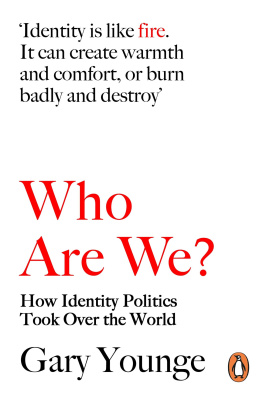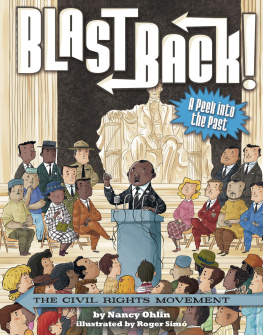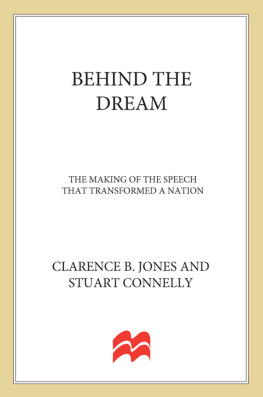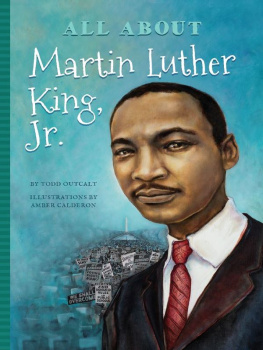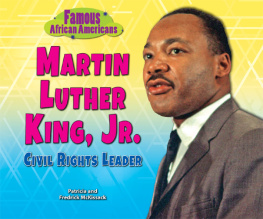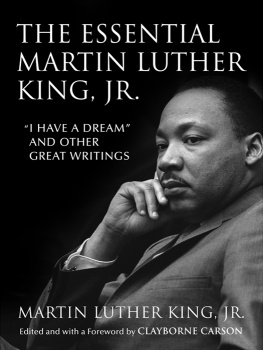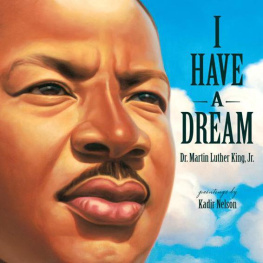Contents
Acknowledgments
This book stems from my long-standing interest in the American South and commitment to issues of social justice. The two came together, not for the first time, in 2011 when I conducted two public interviews, in London and Glasgow, with Clarence Jones, who wrote the draft text of Martin Luther Kings speech at the March on Washington. I have long been intrigued by how the speech became lionized and the wildly conflicting interpretations of it that have circulated. And my conversations with Jones, both on and off stage, showed me that the manner in which the speech was written and delivered, the political moment that made it possible, and the occasion at which it was given said as much about the speech as the words themselves.
This book includes many interviews I have conducted over the last sixteen years with a range of civil rights leaders, activists, and other political and cultural commentators. To present a full and vivid portrayal, it also weaves together a number of other autobiographical and historical accounts of which I am not the source. All are listed in the bibliography and credited frequently throughout the book. But in the absence of footnotes and out of respect for their contributions, I would also like to express a particular debt of gratitude to the hard work and scholarship of a few without whom this book would not have been possible: Drew Hansen, author of The Dream: Martin Luther King Jr. and the Speech That Inspired a Nation ; Charles Euchner, who wrote Nobody Turn Me Around: A Peoples History of the 1963 March on Washington ; Nick Bryant, author of The Bystander: John F. Kennedy and The Struggle for Black Equality ; and Taylor Branch for Parting the Waters: America in the King Years, 195463 . These books were not just invaluable to my research, they are invaluable, period.
Also crucial to this book and the body of work focusing on this era are Eyes on The Prize by Juan Williams, The Life and Times of Bayard Rustin by John DEmilio, and My Soul Is Rested by Howell Raines, as well as the accounts of Clarence Jones in Behind the Dream and John Lewis in Walking with the Wind .
Id also like to thank Julie Fain, my Haymarket editor, for immediately realizing the potential for this book and supporting me throughout its writing; Anthony Arnove, also of Haymarket, for his lucid and consistent advice and encouragement; Ruth Goring, whose precision and clarity made substantial improvements; and the staff at Haymarket whove worked so hard to promote the book within a tight schedule. In his editing of the first draft, Colin Robinsons speed and attention to detail went above and beyond the call of duty. I thank my agent, Jonny Geller, for more than a decade of advocating for my work and representing my interests on both sides of the Atlantic.
Finally, Id like to thank Tara and Osceola for bearing with me as I wrote it, and Zora, who came into this world right in the middle of it.
Bibliography
Anderson, Jervis. A. Philip Randolph: A Biographical Portrait. Berkeley: University of California Press, 1972.
Angelou, Maya. All Gods Children Need Traveling Shoes. London: Virago, 1987.
Branch, Taylor. Parting the Waters: America in the King Years, 195463. New York: Simon & Schuster, 1988.
Brinkley, Douglas. Mine Eyes Have Seen the Glory: The Life of Rosa Parks. London: Weidenfeld and Nicolson, 2000.
Carr, Edward Hallett. What Is History? The George Macauley Trevelyan Lectures Delivered in the University of Cambridge, JanuaryMarch 1961. London: Penguin, 1990.
Cash, Wilbur Joseph. The Mind of the South. New York: Vintage, 1991.
Clayborne, Carson, et al. The Eyes on the Prize Civil Rights Reader: Documents, Speeches and Firsthand Accounts from the Black Freedom Struggle, 19541990. New York: Penguin, 1991.
Bryant, Nick. The Bystander: John F. Kennedy and the Struggle for Black Equality. New York: Basic Books, 2006.
DEmilio, John. Lost Prophet: The Life and Times of Bayard Rustin. Chicago: University of Chicago Press, 2003.
Dyson, Michael Eric. I May Not Get There with You: The True Martin Luther King Jr. New York: Free Press, 2001.
Euchner, Charles. Nobody Turn Me Around: A Peoples History of the 1963 March on Washington. Boston: Beacon, 2010.
Farmer, James. Lay Bare the Heart: An Autobiography of the Civil Rights Movement. New York: Plume, 1986.
Frady, Marshall. Martin Luther King, Jr. New York: Viking, 2002.
. Wallace: The Classic Portrait of Alabama Governor George Wallace. New York Random House, 1968.
Gladwell, Malcolm. Blink: The Power of Thinking without Thinking. New York: Little Brown, 2005.
Hampton, Henry, and Steve Fayer. Voices of Freedom: An Oral History of the Civil Rights Movement from the 1950s through the 1980s. New York: Bantam Books, 1991.
Hansen, Drew D. The Dream: Martin Luther King, Jr., and the Speech That Inspired a Nation. New York: HarperCollins, 2003.
Honey, Michaek K. Going down Jericho Road: The Memphis Strike, Martin Luther Kings Last Campaign. New York: W. W. Norton, 2007.
Johnson, James Weldon. Gods Trombones: Seven Negro Sermons in Verse. New York: Penguin, 2008.
Jones, Clarence B., and Stuart Connelly. Behind the Dream: The Making of the Speech That Transformed a Nation. New York: Palgrave, 2010.
Kapuscinski, Ryszard. Shah of Shahs. New York: Vintage, 1992.
Lewis, John, with Michael DOrso. Walking with the Wind: A Memoir of the Movement. New York: Simon & Schuster, 1998.
Marable, Manning. Malcolm X: A Life of Reinvention. New York: Viking, 2011.
Marqusee, Mike. Redemption Song: Muhammad Ali and the Spirit of the Sixties. London: Verso, 2000.
Marx, Karl. The Eighteenth Brumaire of Louis Bonaparte. Peking: Foreign Language Press, 1978.
Moody, Anne. Coming of Age in Mississippi: The Classic Autobiography of Growing Up Poor and Black in the Rural South. New York: Laurel, 1968.
Raines, Howell. My Soul Is Rested: The Story of the Civil Rights Movement in the Deep South. New York: Penguin, 1977.
Remnick, David. The Bridge: The Life and Rise of Barack Obama. New York: Vintage Books, 2010.
Roberts, Gene, and Hank Klibanoff. The Race Beat: The Press, the Civil Rights Struggle and the Awakening of a Nation. New York: Vintage, 2006.
Robin, Corey. The Reactionary Mind: Conservatism from Edmund Burke to Sarah Palin. New York: Oxford University Press, 2010.
Williams, Juan. Eyes on the Prize: Americas Civil Rights Years, 195465. New York: Penguin, 1987.
The Moment
On February 1, 1960, seventeen-year-old Franklin McCain and three Black friends went to the whites-only counter at Woolworths in Greensboro, North Carolina, and took a seat. We wanted to go beyond what our parents had done....The worst thing that could happen was that the Ku Klux Klan could kill us... but I had no concern for my personal safety. The day I sat at that counter I had the most tremendous feeling of elation and celebration, he told me. I felt that in this life nothing else mattered.... If theres a heaven I got there for a few minutes. I just felt you cant touch me. You cant hurt me. Theres no other experience like it.
A few years later, in May 1963, in Birmingham, Alabama, a burly white police officer attempted to intimidate some Black schoolchildren to keep them from joining the growing antisegregation protests. They assured him they knew what they were doing, ignored his entreaties, and continued their march toward Kelly Ingram Park, where they were arrested. A reporter asked one of them her age. Six, she said, as she climbed into the paddy wagon.
The following month in Mississippi, stalwart civil rights campaigner Fannie Lou Hamer overheard Annell Ponder, a fellow campaigner, being beaten in jail in an adjacent cell.
Can you say yes, sir, nigger? Can you say yes, sir? the policeman demanded.


